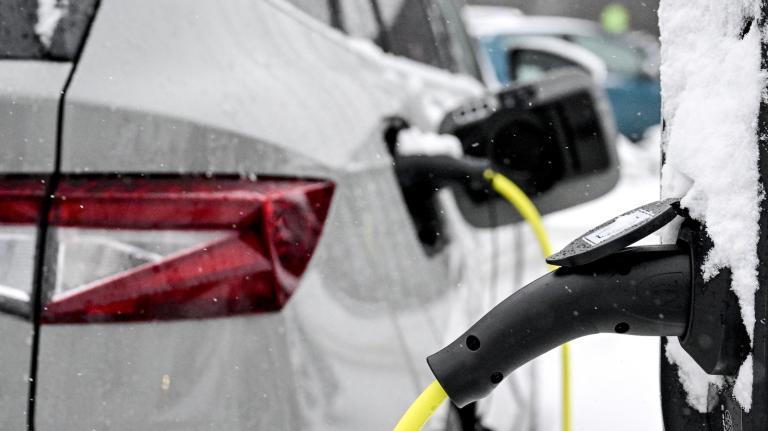There’s a bit of a disturbing trend in the automotive world right now. Several traditional automakers are suddenly easing off the electrification accelerator in response to a perceived slowdown in EV interest and sales.
Whether that slowdown is real or just growing pains, the result is the same: Automakers are reacting. Major manufacturers are backsliding on their once-aggressive timelines for full electrification, and what was shaping up to be a largely electrified transportation landscape by the end of the decade is now looking like more of the same.
To be clear, progress is still being made. EV sales are up overall, and the transition away from internal combustion and its associated carbon dioxide emissions is happening, just with a little less momentum than once predicted.
Which automakers are walking back EV goals?
Ford, the best-selling automaker in the U.S., is among the most recent and most notable players to shift its electrification plans. The Blue Oval stated in 2021 that it would have an all-electric option for all of its models by 2026 and an entirely electric portfolio by 2030 — at least in Europe. An electric three-row SUV was due in 2025.
The deadline for that SUV shifted to 2027 earlier this year, with Ford president and CEO Jim Farley noting that the firm is “committed to scaling a profitable EV business, using capital wisely and bringing to market the right gas, hybrid, and fully electric vehicles at the right time.”
But in late August, plans changed again. That three-row SUV was put on indefinite hold, delivery dates for a pair of electric trucks slipped, and Ford slashed its EV development budget by roughly $12 billion.
Mercedes-Benz likewise set some aggressive goals in 2021, including a plan to invest 40 billion euros ($44 billion) to ensure that by 2025, half the company’s sales were electric vehicles.
Now only a year away from that milestone, the goalpost has moved. The brand aspires to be half-electrified by 2030 — and only “where market conditions allow.” That’s a big caveat. While the company didn’t provide any specifics around that target, less than 7 percent of its U.S. sales are EVs, per Edmunds. It’s hard to imagine that market meeting the company’s definition of fertile conditions.
Another German auto giant, Volkswagen, has recently softened its plans to build six battery factories around the world. Now the company says its three already-announced factories may be enough to meet demand through 2030.
“The expansion of the plants will depend on how the market for e-cars develops,” VW chief technology officer Thomas Schmall told the Frankfurter Allgemeine Zeitung newspaper.
Volvo is also on the list of automakers that made big EV promises back in 2021. The firm pledged to “become a fully electric car company by 2030.” It’s released several charming EVs since then and attempted to release a few more that have struggled on the way to market. These include the interesting and affordable EX30 crossover, which got caught in the crossfire of the Chinese EV import tariffs and now won’t land in North America until 2025, and the large and luxurious three-row EX90, which is finally entering production after software-related delays.
CEO Jim Rowan doubled down on Volvo’s ambitious goal in May, saying the 2030 target is “a very achievable future.” However, in an investor call a few weeks later, he said, “Our plug-in hybrids and mild hybrids remain very strong and popular with our customers, and we will continue to invest in this lineup.”
So, although Volvo hasn’t announced a formal easement of the goal yet, it certainly sounds like it’s coming.
Why are automakers hitting the brakes on EVs?
The main reason for the scaleback cited by manufacturers is the perception that people are a little slower on the EV uptake than anticipated.
This one’s a little hard to parse, owing to some conflicting numbers. On the one hand, you see U.S. figures like Ford EV sales up by 61 percent this past quarter compared with sales the year before, and BMW EV sales are up by almost 25 percent. But the outlook for other brands isn’t so rosy. Mercedes-Benz EV sales in Q2, for example, were down by 25 percent over the previous year, while Volkswagen’s EV sales were basically flat.
Overall, though, Q2 2024 U.S. EV sales were up by over 11 percent compared with sales the prior year, and by 23 percent over the prior quarter, per Cox Automotive. According to New AutoMotive’s Global Electric Vehicle Tracker, the U.S. market outpaced the global EV market, which was up by 19 percent over the first quarter.
With the perception that EVs are too big a leap for U.S. consumers, hybrids — particularly those of the plug-in variety — are again being seen by manufacturers as a gateway to full electrification.
Whether this is a valid decarbonization strategy is debatable. Hybrids add even more complexity and weight to an already complex internal combustion car. The promise, of course, is increased efficiency. However, the International Council on Clean Transportation found that since most people don’t plug in their PHEVs, their overall emissions are significantly higher than the EPA estimates would imply — upwards of 67 percent worse.
For Ford, at least, a renewed focus on cost is the main driver of its recent EV scaleback. That makes sense: In the early 2020s, when many brands were issuing their bold EV-only sentiments, there was an expectation that battery costs would drop significantly as manufacturing scale increased.
Unfortunately, that hasn’t come to pass.
If there was one unifying misstep among automakers, policymakers, and general consumers, it was a willingness to believe that once EVs started hitting the market, they would basically sell themselves. Auto execs did nothing to temper those expectations; many of them were swept up in the excitement themselves.
Sadly, consumers, particularly in the U.S., require a little more convincing. That will be difficult so long as governments, both local and federal, continue doing a terrible job of building out an accessible, reliable nationwide EV charging network. And while in the U.S., the Inflation Reduction Act’s EV tax credits help a bit, the fact is that most EVs on the market still cost considerably more than a comparable gas-powered car. As long as that’s the case, EVs will continue to be difficult to sell.
Since so many expected that EV sales would skyrocket immediately, any slowdown could be perceived as a failure. But here’s the thing: Slower-than-expected growth is still growth. More EVs are being sold than ever, even if sales aren’t rising at exponential rates.
It took more than 20 years for leaded gasoline to be phased out in the U.S. market, and that shift was nothing compared to what’s involved here. Automakers walking back aggressive timelines is not a sign that EVs were a failed experiment; it just means that sometimes consumer sentiment moves a little more slowly than technology.






